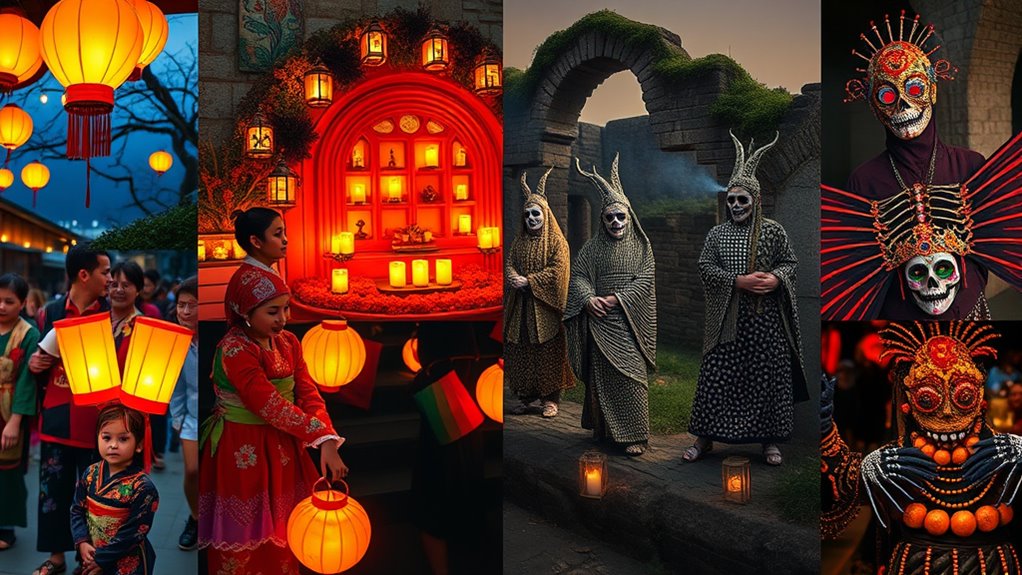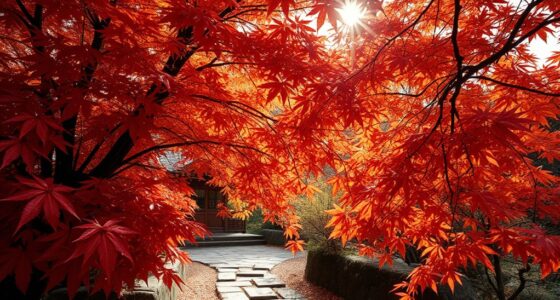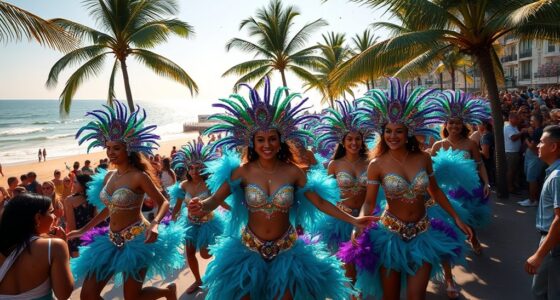Halloween’s celebrations vary widely across the globe. In the U.S., you’ll find trick-or-treating and haunted attractions, while European countries blend Christian traditions with ancient pagan customs. Latin American festivals honor ancestors through colorful altars for Día de los Muertos, and Caribbean rituals celebrate spirits artistically. In Asia, indigenous festivals like Obon and Hungry Ghost Festival focus on ancestor reverence. To discover how different cultures make the spooky season their own, keep exploring these fascinating traditions.
Key Takeaways
- Halloween’s origins stem from Celtic Samhain, involving bonfires, costumes, and honoring ancestors, influencing modern celebrations worldwide.
- North American Halloween features trick-or-treating and haunted attractions, with a market valued at around $11.7 billion.
- European customs blend Christian remembrance with ancient folk rituals, such as pumpkin festivals and bonfires to ward off evil spirits.
- Latin American Día de los Muertos emphasizes vibrant altars, cemetery visits, and offerings to honor ancestors respectfully.
- Asian festivals like Obon and Hungry Ghost Festival focus on ancestor worship through lanterns, offerings, and traditional rituals.
The Roots of Halloween: Celtic Traditions and Their Influence
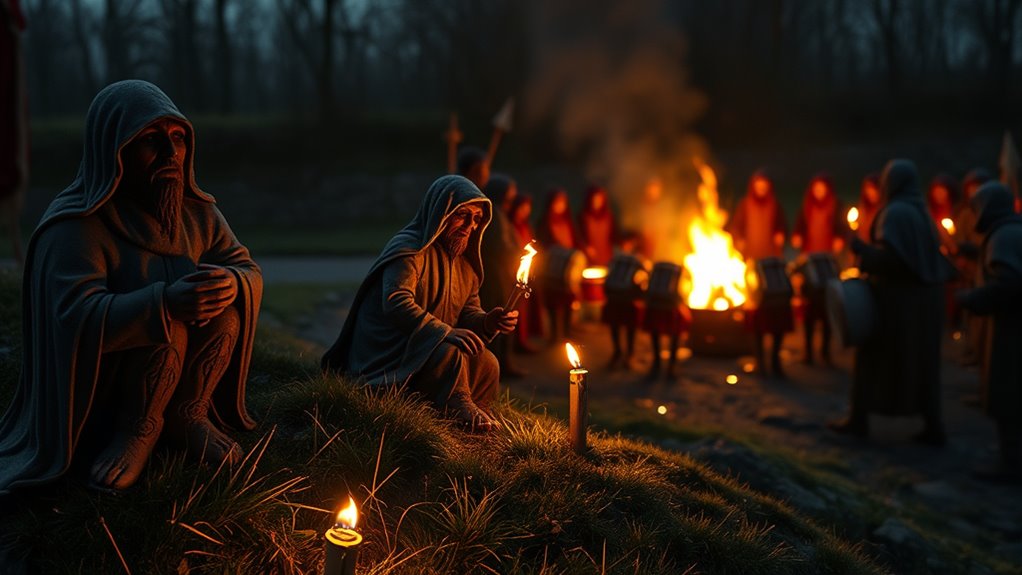
The roots of Halloween lie in ancient Celtic traditions, particularly the festival of Samhain, which was celebrated around 2,000 years ago in Ireland. During this time, Celtic symbolism played a key role in their rituals, emphasizing the boundary between the living and spirit worlds. Samhain rituals involved lighting bonfires to symbolize renewal and protection, and bones from slaughtered livestock were cast into fires as offerings. People wore costumes and masks—often animal skins or heads—to disguise themselves from harmful spirits, a practice rooted in the belief that disguises could ward off malevolent entities. These customs reflected a deep respect for ancestors and the cycle of seasons, shaping the spiritual themes that later influenced Christian traditions and modern Halloween celebrations. Additionally, the use of vintage decor and symbolic objects in rituals helped reinforce these spiritual connections and cultural identities.
North American Celebrations: Trick-or-Treating and Haunted Attractions

In North America, Halloween celebrations come alive through traditions like trick-or-treating and visits to haunted attractions, drawing millions of participants each year. You’ll notice popular costume trends that range from classic monsters to creative DIY outfits, with many starting their costume shopping early to avoid last-minute rushes. Haunted attractions are a key part of the season, offering immersive experiences that attract around 25% of adults, especially younger demographics such as Gen Z. These haunted houses and themed events add excitement beyond trick-or-treating, highlighting the holiday’s commercial appeal. With a growing focus on seasonal engagement through unique candies and themed costumes, the festive spirit extends from neighborhood doorsteps to elaborate haunted attractions, making Halloween a vibrant and lucrative season for both consumers and small businesses alike. The US Halloween market is valued at approximately $11.7 billion, reflecting its significance as a major seasonal industry.
European Variations: From Italy’s All Saints’ Day to Austria’s Pumpkin Festivals
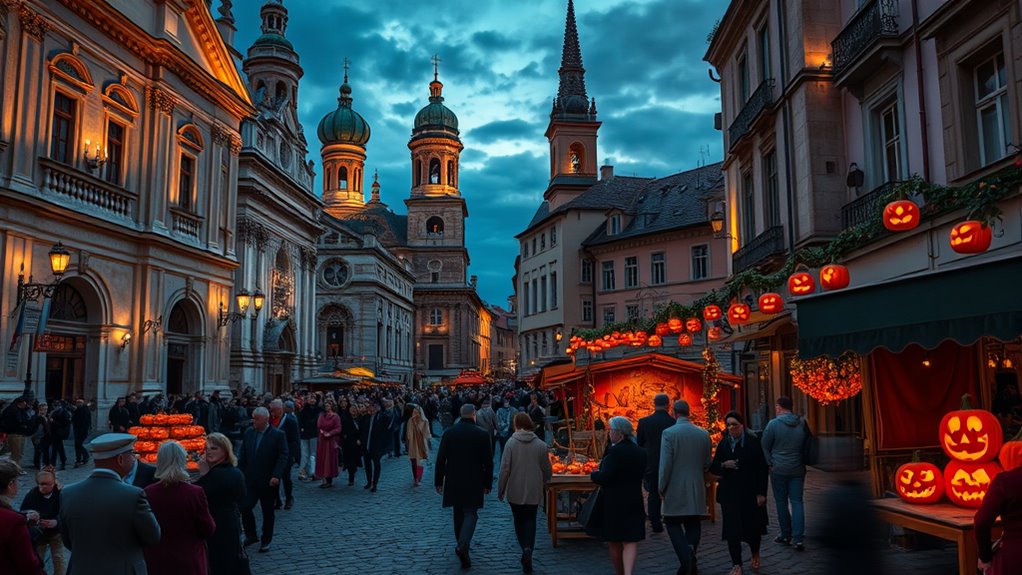
Across Europe, Halloween customs blend ancient traditions with local cultural practices, creating a diverse tapestry of festivities that differ from North America’s focus on costumes and haunted attractions. In Italy, All Saints’ Day and All Souls’ Day honor ancestors through cemetery visits, flower offerings, and regional sweets like “ossa dei morti,” emphasizing remembrance over spooky fun. Austria’s Seelenwoche involves leaving bread and water for departed spirits, while pumpkin festivals celebrate harvest with crafts and markets, often featuring carved turnips or beets rooted in folk healing rituals. Bonfires ward off evil spirits, echoing Celtic practices of storytelling and medieval ghost stories. These customs highlight how communities reconnect with their history, blending Christian remembrance with ancient folk traditions. Additionally, the Horsepower of electric dirt bikes has contributed to the popularity of eco-friendly transportation, influencing some regions to incorporate sustainable practices into their celebrations.
Latin American and Caribbean Festivities: Día De Los Muertos and Vodou Rituals
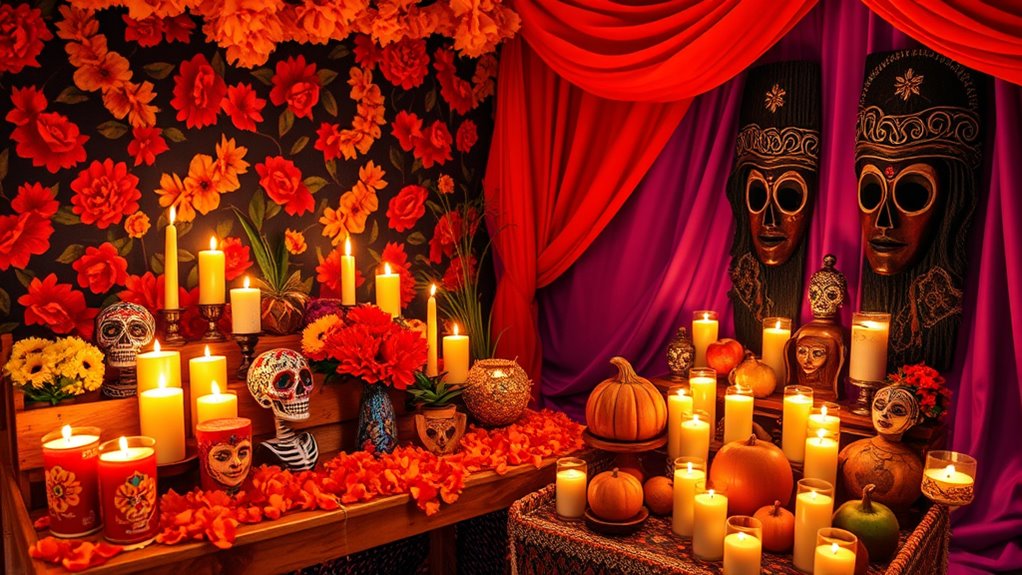
Día de los Muertos and Vodou rituals stand out as vibrant expressions of cultural identity that honor ancestors and celebrate life beyond death. You’ll see sacred altars, or ofrendas, decorated with photos, marigold flowers, candles, and ancestral offerings, creating a warm space for remembrance. During these festivities, families visit cemeteries to decorate graves with personal belongings, candles, and flowers, turning mourning into joyful remembrance. Traditional foods like pan de muerto and sugar skull candies symbolize the connection between the living and the dead. In the Caribbean, Vodou rituals involve offerings, music, dance, and spirit possession to communicate with ancestors and spirits. These practices highlight a collective respect for ancestors, emphasizing life, memory, and cultural roots rather than fear or horror. Additionally, contrast ratio plays a role in visual displays during these celebrations, enhancing the vibrancy and clarity of decorations and altars.
Asian Perspectives: Western Influence and Indigenous Festivals
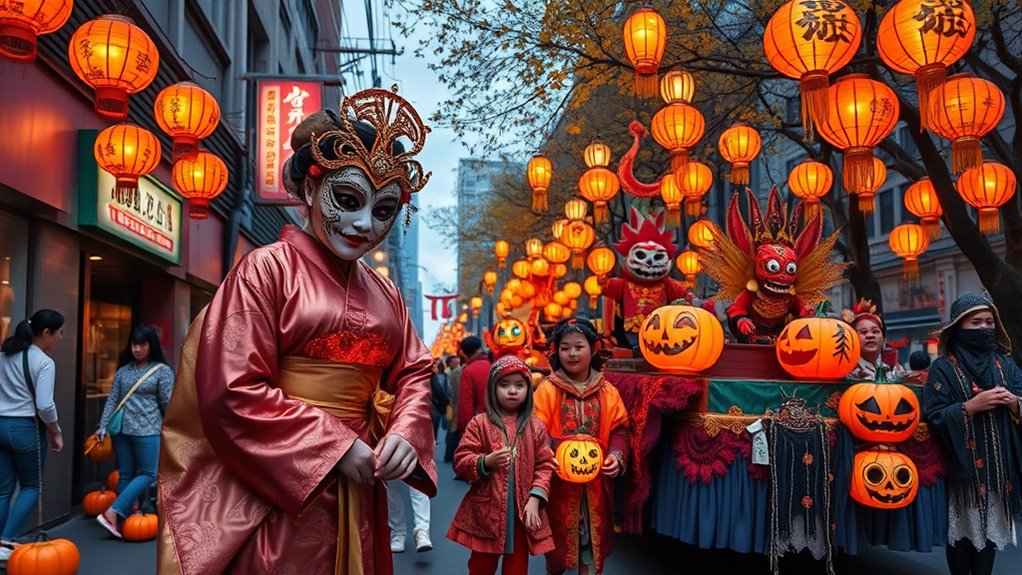
Asian cultures have long celebrated indigenous festivals that honor ancestors and spirits, emphasizing reverence and remembrance over fear or entertainment. These festivals, like the Hungry Ghost Festival in China, Malaysia, and Vietnam, involve offerings and rituals to appease wandering spirits, focusing on ancestor worship and spiritual connection. Japan’s Obon Festival honors ancestors through lantern lighting and grave visits, while Thailand’s Phi Ta Khon blends ancestral homage with colorful masks and dances. With urban adaptation, these traditions have evolved in cities like Hong Kong and Singapore, where modern celebrations incorporate traditional ancestor rituals into contemporary events. Western influence has introduced Halloween’s spooky motifs, but these indigenous practices remain rooted in solemn remembrance, creating a cultural fusion that respects ancestral ties while adapting to urban lifestyles. This blending showcases the importance of cultural intelligence in understanding and appreciating diverse spiritual expressions across regions.
Frequently Asked Questions
How Did Halloween Evolve From Celtic Origins to Modern Celebrations Worldwide?
You see how Halloween evolved from Celtic origins through historical evolution and cultural adaptation. It started as Samhain, a pagan festival marking seasonal change and spirits. As Christianity integrated, it became All Hallows’ Eve. Immigrants brought traditions to America, blending with local customs. Now, Halloween’s a global celebration emphasizing costumes and fun, shifting to different cultures while retaining its roots in honoring the dead and marking seasonal transitions.
What Are the Unique Halloween Traditions in Countries Outside North America and Europe?
You’ll find unique Halloween traditions outside North America and Europe, like in the Philippines, where kids go door-to-door singing for treats and families visit graves. In China, families offer food to spirits during Ghost Festival. Nepal’s Gai Jatra involves children dressing as cows, and Latin America celebrates Día de los Muertos with colorful altars. These cultures emphasize honoring spirits through offerings and community rituals instead of pumpkin carving or haunted house tours.
How Do Indigenous and Local Beliefs Influence Halloween-Like Festivities Globally?
Did you know that over 70% of Halloween-like festivals worldwide incorporate indigenous rituals or local folklore? You see, these traditions deeply influence how communities celebrate seasons of remembrance and harvest. Indigenous beliefs shape symbols like carved gourds or ancestor offerings, blending old customs with modern festivities. By respecting these practices, you gain a richer understanding of cultural diversity and how local stories and rituals continue to thrive amidst global celebrations.
Why Do Some Cultures Focus on Honoring the Dead Rather Than Fear During Halloween?
You see, some cultures focus on honoring the dead instead of fear because they value ancestral remembrance and spiritual reverence. These traditions aim to celebrate life and maintain strong bonds with loved ones who have passed away. Instead of frightening imagery, they use rituals like altars and offerings to show respect, invite spirits, and foster community, emphasizing remembrance and connection over superstition or horror.
What Role Do Commercial Interests Play in Shaping Halloween Festivities Across Different Regions?
Imagine vibrant costumes and glowing decorations transforming streets into lively scenes. Commercial influence and marketing strategies shape these festivities, guiding what you buy and wear. Retailers start early, pushing costumes, candies, and decorations to spark excitement. Across regions, this commercial push creates hybrid traditions, blending local culture with global trends. You feel the buzz as brands shape your Halloween experience, making it a colorful, consumer-driven celebration that evolves with marketing tactics.
Conclusion
As you explore Halloween around the world, think of it as a tapestry woven from diverse threads—each culture adding its unique color and pattern. Just like a quilt, these traditions keep you warm with shared stories of ancestors, spirits, and celebration. Embrace the journey, knowing that behind each spooky mask lies a universal desire to connect with the past and celebrate life’s mysteries. In this dance of shadows, we find our common heartbeat.
